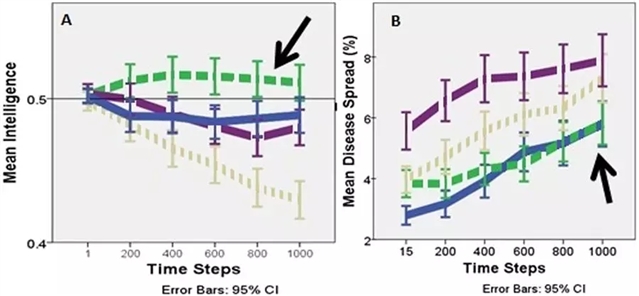论文标题:Social Structure Facilitated the Evolution of Care-giving as a Strategy for Disease Control in the Human Lineage
期刊:Scientific Reports
作者:Sharon E. Kessler, Tyler R.Bonnell, Joanna M. Setchell, Colin A. Chapman
发表时间:2018/09/27
数字识别码:10.1038/s41598-018-31568-2
原文链接:https://www.nature.com/articles/s41598-018-31568-2?utm_source=Other_website&utm_medium=Website_links&utm_content=RenLi-MixedBrand-multijournal-Multidisciplinary-China&utm_campaign=ORG_USG_JRCN_RL_article_promotion_sciencenet_Oct_2nd
微信链接:https://mp.weixin.qq.com/s/dForV167C2GtmpS7lnQkRQ
根据《科学报告》发表的一项研究Social Structure Facilitated the Evolution of Care-giving as a Strategy for Disease Control in the Human Lineage,随着社会网络变得日渐复杂,社会传播疾病的威胁不断增加,照顾病人可能使史前人类能够预防疾病传播。

图源:Pexels
英国杜伦大学的Sharon Kessler及其同事使用计算机模型来模拟护理在四种不同社会系统中的演变,他们重建了包含50-200人的早期能人(Homo habilis)、直立人(H. erectus)、海德堡人(H. heidelbergensis)、尼安德特人(H. neandertalensis)和智人(H. sapiens)社群。作者表明,在有效的护理策略确立之前,由父母、兄弟姐妹、堂(表)兄弟姐妹和其他家庭成员负责的亲属护理制度最有可能促进护理在人类种群中的演化。他们认为这是因为家庭成员会分担护理和相关疾病暴露的成本,从而限制个体的感染风险。与此同时,疾病的传播风险会限于家庭成员内部,从而防止疾病向外传播。一旦确立了有效的护理策略,护理网络就变得更加灵活,促进提高人类社会系统的复杂性和多样性。

图2:小社群平均智力(A)和疾病传播(B)随时间的变化。绿色表示基于亲属的社群,蓝色表示灵长类基准线,淡金色表示两人组,紫色表示间接的互惠群体。图源:Kessler
作者认为随着古人类的演化,护理也会产生选择压力,这可能促进某些典型的人类特征的演化,比如支持疾病识别和合作护理的心理、社会与认知特性;使疾病症状更易于发现的生理特征;以及对会在护理人中间传播的病原体产生相适应的免疫系统。
因此,作者总结表示,护理可能是与人类种群成功相关的心理和行为特征的关键因素,而抑制疾病传播的能力可能是人类社会复杂性演变的基础。
摘要:Humans are the only species to have evolved cooperative care-giving as a strategy for disease control. A synthesis of evidence from the fossil record, paleogenomics, human ecology, and disease transmission models, suggests that care-giving for the diseased evolved as part of the unique suite of cognitive and socio-cultural specializations that are attributed to the genus Homo. Here we demonstrate that the evolution of hominin social structure enabled the evolution of care-giving for the diseased. Using agent-based modeling, we simulate the evolution of care-giving in hominin networks derived from a basal primate social system and the three leading hypotheses of ancestral human social organization, each of which would have had to deal with the elevated disease spread associated with care-giving. We show that (1) care-giving is an evolutionarily stable strategy in kin-based cooperatively breeding groups, (2) care-giving can become established in small, low density groups, similar to communities that existed before the increases in community size and density that are associated with the advent of agriculture in the Neolithic, and (3) once established, care-giving became a successful method of disease control across social systems, even as community sizes and densities increased. We conclude that care-giving enabled hominins to suppress disease spread as social complexity, and thus socially-transmitted disease risk, increased.
阅读论文全文请访问:https://www.nature.com/articles/s41598-018-31568-2?utm_source=Other_website&utm_medium=Website_links&utm_content=RenLi-MixedBrand-multijournal-Multidisciplinary-China&utm_campaign=ORG_USG_JRCN_RL_article_promotion_sciencenet_Oct_2nd
期刊介绍:Scientific Reports (https://www.nature.com/srep/) is an online, open access journal from the publishers of Nature. We publish scientifically valid primary research from all areas of the natural and clinical sciences.
The 2017 journal metrics for Scientific Reports are as follows:
•2-year impact factor: 4.122
•5-year impact factor: 4.609
•Immediacy index: 0.576
•Eigenfactor® score: 0.71896
•Article Influence Score: 1.356
•2-year Median: 2
(来源:科学网)
特别声明:本文转载仅仅是出于传播信息的需要,并不意味着代表本网站观点或证实其内容的真实性;如其他媒体、网站或个人从本网站转载使用,须保留本网站注明的“来源”,并自负版权等法律责任;作者如果不希望被转载或者联系转载稿费等事宜,请与我们接洽。